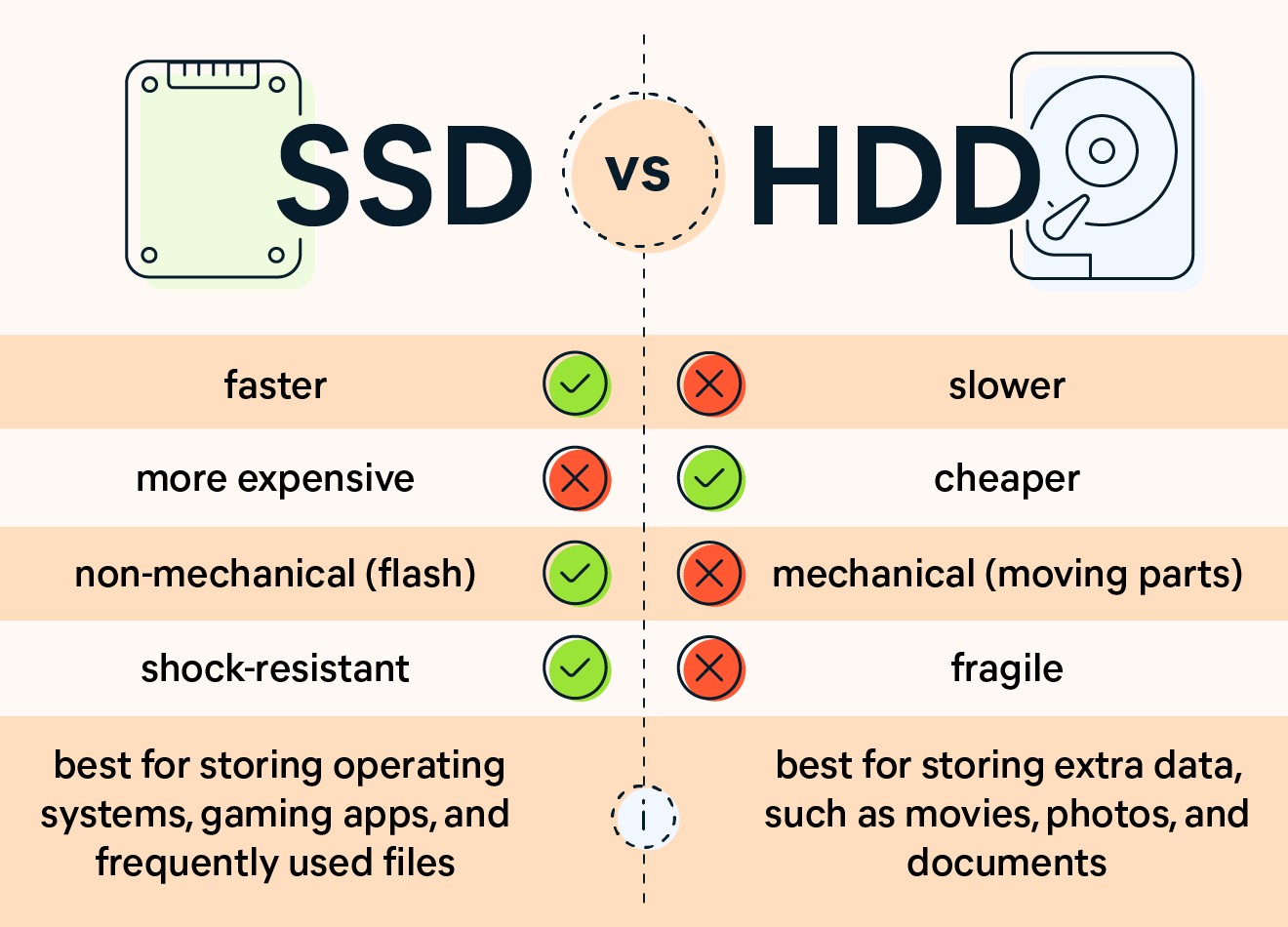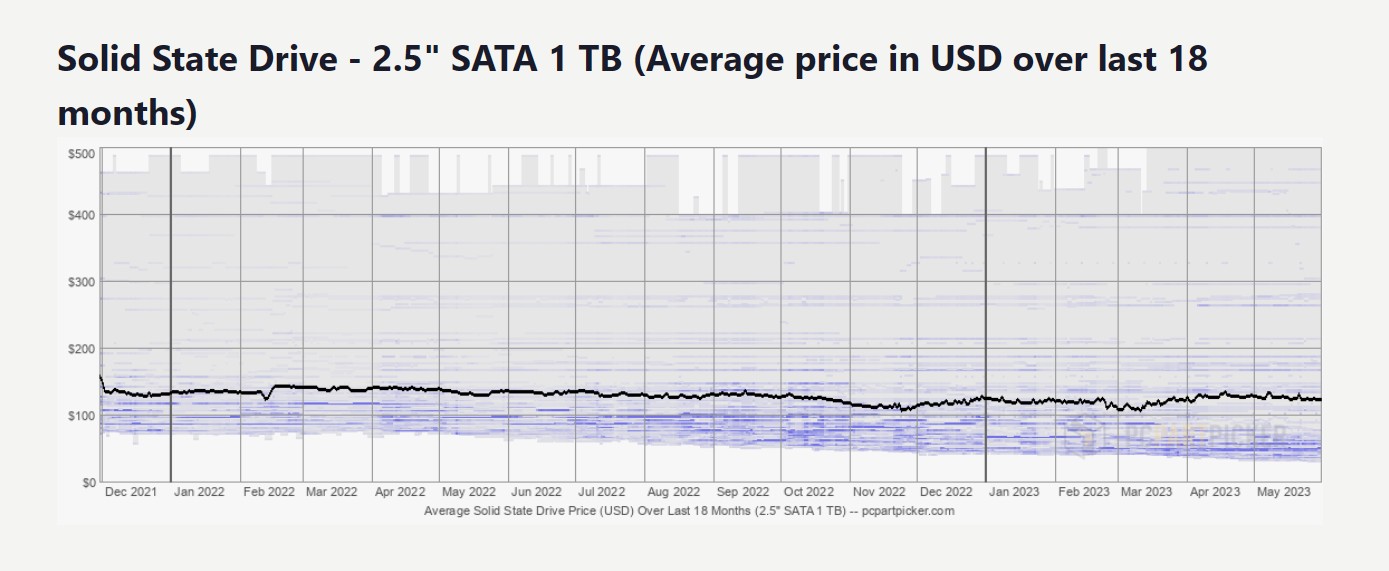How Fast Is Ssd Compared To Hdd? The performance differences between Solid State Drives (SSDs) and Hard Disk Drives (HDDs) are significant, impacting everything from boot times to application loading. At COMPARE.EDU.VN, we delve into the comparative analysis of these storage solutions. Uncover the benefits of SSD technology, exploring faster data access and enhanced system responsiveness, which makes it the ideal choice for users who need efficient computing and data accessibility.
1. Understanding SSDs and HDDs
To truly understand how fast an SSD is compared to an HDD, it’s essential to grasp the fundamental differences between these two storage technologies. HDDs, the older technology, rely on mechanical spinning disks to store data. A read/write head moves across these disks to access information. This mechanical process introduces latency, affecting the speed at which data can be retrieved or written.
In contrast, SSDs are based on flash memory technology, storing data electronically on interconnected flash memory chips. This eliminates the need for any moving parts. As a result, SSDs offer significantly faster data access times, lower latency, and improved overall system responsiveness.
1.1. What is a Solid State Drive (SSD)?
Solid State Drives (SSDs) represent a leap forward in data storage technology. Unlike their mechanical counterparts, SSDs store data on flash memory chips, enabling instant data accessibility. This results in significantly faster read and write speeds. The absence of moving parts also makes SSDs more durable and less susceptible to physical damage.
SSDs are available in various form factors, including 2.5-inch drives, M.2 modules, and add-in cards. They connect to your computer via interfaces such as SATA, PCIe, or NVMe. This provides flexibility in terms of compatibility and performance.
1.2. What is a Hard Disk Drive (HDD)?
Hard Disk Drives (HDDs) have been a staple of data storage for decades. They consist of spinning platters coated with a ferromagnetic material, where data is stored as magnetic patterns. A read/write head, mounted on an actuator arm, moves across the platters to access data.
The mechanical nature of HDDs introduces latency, which can impact overall performance. The speed at which the platters spin, measured in revolutions per minute (RPM), also affects data transfer rates. Common HDD speeds include 5400 RPM and 7200 RPM.
2. SSD vs HDD: Key Differences
The choice between an SSD and an HDD depends on your specific needs and budget. SSDs excel in speed, durability, and power efficiency. HDDs offer higher storage capacities at a lower cost.
| Feature | SSD | HDD |
|---|---|---|
| Speed | Significantly faster | Slower |
| Durability | More durable, no moving parts | Less durable, mechanical components |
| Power Consumption | Lower | Higher |
| Storage Capacity | Typically lower | Typically higher |
| Price | More expensive per GB | Less expensive per GB |
| Noise | Silent operation | Audible spinning and clicking |
| Fragmentation | Not susceptible to fragmentation | Susceptible to fragmentation |



2.1. Speed and Performance
SSDs offer a dramatic improvement in speed and performance compared to HDDs. The difference is noticeable in various tasks, including:
- Boot times: SSDs can boot operating systems in a matter of seconds, while HDDs may take significantly longer.
- Application loading: Applications launch much faster from an SSD, reducing wait times and improving productivity.
- File transfer: SSDs can transfer large files at much higher speeds, accelerating tasks such as video editing and data backup.
- Gaming: SSDs can reduce game loading times and improve overall gaming performance.
2.2. Durability and Reliability
SSDs are more durable than HDDs due to the absence of moving parts. This makes them less susceptible to damage from physical shocks and vibrations. SSDs are a better choice for laptops and other portable devices that may experience rough handling.
While SSDs were once considered less reliable than HDDs, advancements in technology have significantly improved their lifespan and reliability. Modern SSDs can withstand a large number of write cycles and offer comparable or even superior reliability compared to HDDs.
2.3. Power Consumption and Efficiency
SSDs consume significantly less power than HDDs. The absence of moving parts translates into lower energy consumption, which can lead to longer battery life for laptops and reduced electricity costs for desktop computers.
The lower power consumption of SSDs also results in less heat generation, which can help to keep your system running cooler and more efficiently.
3. How Much Faster Are Solid State Drives Compared to Hard Disk Drives?
The speed difference between SSDs and HDDs is substantial. SSDs can be several times faster than HDDs in many tasks. To illustrate this, let’s look at some specific benchmarks:
- Sequential read speeds: SSDs can achieve sequential read speeds of up to 550 MB/s or more, while HDDs typically top out at around 150 MB/s.
- Sequential write speeds: SSDs can reach sequential write speeds of up to 520 MB/s or more, while HDDs typically range from 50 MB/s to 120 MB/s.
- Random read/write speeds: SSDs excel in random read/write operations, which are crucial for tasks such as operating system boot-up and application loading. SSDs can achieve random read/write speeds that are hundreds of times faster than HDDs.
3.1. Boot Times
One of the most noticeable differences between SSDs and HDDs is boot time. A computer with an SSD can boot up in a matter of seconds, while a computer with an HDD may take a minute or more.
The faster boot times of SSDs are due to their ability to quickly access and load the operating system files. This results in a more responsive and efficient computing experience.
3.2. Application Loading
SSDs can significantly reduce application loading times. Applications launch much faster from an SSD. You can work productively without waiting for programs to load.
The faster application loading times of SSDs are due to their ability to quickly access and load application files. This translates into a more seamless and enjoyable user experience.
3.3. File Transfer Speeds
SSDs can transfer large files at much higher speeds than HDDs. This can save you a significant amount of time when copying or moving files, especially large video files or data backups.
The faster file transfer speeds of SSDs are due to their high sequential read and write speeds. This makes them a great option for content creators, gamers, and anyone who works with large files.
3.4. Gaming Performance
SSDs can improve gaming performance by reducing game loading times. The stuttering can be reduced while gaming, as the game data is loaded more quickly.
The faster loading times and improved responsiveness of SSDs can enhance the overall gaming experience.
4. SSD Speed: A Deeper Dive
To fully appreciate the speed advantages of SSDs, it’s important to understand the different types of SSDs and their respective performance characteristics.
4.1. SATA SSDs
SATA SSDs are the most common type of SSD. They use the SATA interface, which has a maximum theoretical bandwidth of 6 Gbps (Gigabits per second). While SATA SSDs offer a significant improvement over HDDs, they are limited by the SATA interface.
4.2. NVMe SSDs
NVMe (Non-Volatile Memory Express) SSDs are a newer type of SSD that uses the PCIe (Peripheral Component Interconnect Express) interface. The PCIe interface offers much higher bandwidth than SATA, allowing NVMe SSDs to achieve significantly faster speeds.
NVMe SSDs are available in two main form factors:
- M.2: M.2 NVMe SSDs are small, stick-shaped drives that plug directly into an M.2 slot on the motherboard.
- Add-in card: Add-in card NVMe SSDs plug into a PCIe slot on the motherboard, similar to a graphics card.
4.3. Understanding Read and Write Speeds
Read and write speeds are key performance indicators for SSDs.
- Read speed refers to the rate at which data can be read from the SSD.
- Write speed refers to the rate at which data can be written to the SSD.
SSDs typically advertise both sequential read/write speeds and random read/write speeds. Sequential speeds refer to the speed at which large, contiguous blocks of data can be read or written. Random speeds refer to the speed at which small, non-contiguous blocks of data can be read or written.
Random read/write speeds are particularly important for tasks such as operating system boot-up and application loading.
5. HDD Speed: A Closer Look
While HDDs cannot match the speed of SSDs, it’s important to understand their performance characteristics.
5.1. RPM (Revolutions Per Minute)
The speed at which an HDD’s platters spin is measured in RPM. Common HDD speeds include 5400 RPM and 7200 RPM. Higher RPM drives generally offer faster data transfer rates, but they also consume more power and generate more heat.
5.2. Access Time
Access time refers to the time it takes for the read/write head to move to the correct location on the platter and begin reading or writing data. HDDs have significantly longer access times than SSDs due to their mechanical nature.
5.3. Fragmentation
Fragmentation occurs when files are stored in non-contiguous blocks on the HDD. This can slow down performance, as the read/write head has to move around the platter to access all the parts of the file.
Defragmenting the drive can improve HDD performance by reorganizing files and storing them in contiguous blocks.
6. SSD or HDD: Which One is Right for You?
The choice between an SSD and an HDD depends on your specific needs and budget.
6.1. When to Choose an SSD
An SSD is a better choice if you need:
- Fast boot times: SSDs can boot operating systems in seconds.
- Quick application loading: Applications launch faster.
- Fast file transfer: Save time transferring large files.
- Improved gaming performance: Reduce game loading times.
- Durability and reliability: Less susceptible to physical damage.
- Low power consumption: Longer battery life for laptops.
6.2. When to Choose an HDD
An HDD is a better choice if you need:
- Large storage capacity: HDDs offer higher storage capacities at a lower cost.
- Budget-friendly storage: HDDs are more affordable per GB.
6.3. Hybrid Approach: SSD + HDD
Some users opt for a hybrid approach, combining an SSD for the operating system and frequently used applications with an HDD for mass storage.
This approach offers a balance between speed and capacity, allowing you to enjoy the benefits of an SSD without sacrificing storage space.
7. The Lifespan of SSDs and HDDs
The lifespan of both SSDs and HDDs has improved over the years.
7.1. SSD Lifespan
SSDs have a limited number of write cycles. This means that each cell on the flash memory chip can only be written to a certain number of times before it wears out.
However, modern SSDs use wear leveling techniques to distribute write operations evenly across all cells, extending the lifespan of the drive.
Most SSDs come with a warranty that guarantees a certain number of terabytes written (TBW) or a certain number of years.
7.2. HDD Lifespan
HDDs are susceptible to mechanical failure. The moving parts inside an HDD can wear out over time, leading to data loss.
Factors such as temperature, humidity, and physical shocks can also affect the lifespan of an HDD.
Regular backups are essential to protect your data, regardless of whether you are using an SSD or an HDD.
8. Security and Data Recovery
Data security and recovery are important considerations when choosing between an SSD and an HDD.
8.1. SSD Data Recovery
SSDs use the TRIM command to erase data when files are deleted. This makes it more difficult to recover deleted files from an SSD compared to an HDD.
Data recovery for SSDs is best handled by professionals in a lab with specialized equipment and software.
8.2. HDD Data Recovery
Data recovery from HDDs is generally easier than from SSDs. The data is still present on the platters, even after the file has been deleted.
There are many data recovery tools available that can help you recover deleted files from an HDD.
8.3. Data Security
Both SSDs and HDDs can be encrypted to protect your data from unauthorized access. Encryption scrambles the data on the drive, making it unreadable without the correct password or encryption key.
9. Price Differences Between HDDs and SSDs
Price is a significant factor when choosing between an SSD and an HDD.
9.1. SSD Pricing
SSDs are more expensive than HDDs per gigabyte. The price of SSDs has come down significantly in recent years, but they are still more expensive than HDDs.
9.2. HDD Pricing
HDDs are more affordable per gigabyte. This makes them a great option if you need a large amount of storage space on a budget.
10. How to Choose the Right Drive
Choosing the right drive depends on your needs and budget.
10.1. Consider Your Budget
If you are on a tight budget, an HDD may be the better option. HDDs offer higher storage capacities at a lower cost.
10.2. Assess Your Performance Needs
If speed and performance are important to you, an SSD is a better choice. SSDs offer faster boot times, quick application loading, and fast file transfer speeds.
10.3. Evaluate Your Storage Requirements
Consider how much storage space you need. If you need a large amount of storage space, an HDD may be the better option.
10.4. Think About Your Usage Scenarios
Think about how you will be using your computer. If you will be using it for tasks such as gaming, video editing, or other resource-intensive activities, an SSD is a better choice.
11. Keeping Your Drive in Top Shape
Regular maintenance can help keep your drive running smoothly.
11.1. Defragmenting HDDs
Defragmenting your HDD can improve performance by reorganizing files and storing them in contiguous blocks.
11.2. TRIM Command for SSDs
The TRIM command helps maintain SSD performance by cleaning up unused blocks of data.
11.3. Disk Cleanup
Use disk cleanup tools to remove unnecessary files.
11.4. Monitoring Drive Health
Monitor the health of your drive using diagnostic tools.
12. COMPARE.EDU.VN: Your Partner in Making Informed Decisions
Choosing the right storage solution can be challenging, but COMPARE.EDU.VN is here to help. We provide comprehensive comparisons and detailed information to help you make informed decisions.
12.1. Explore Our In-Depth Comparisons
Visit COMPARE.EDU.VN to explore our in-depth comparisons of SSDs and HDDs.
12.2. Find the Perfect Storage Solution
Find the perfect storage solution for your needs and budget.
12.3. Stay Informed with Our Expert Insights
Stay informed with our expert insights and analysis of the latest storage technologies.
At COMPARE.EDU.VN, we understand the importance of making informed decisions. We are committed to providing you with the resources and information you need to choose the right storage solution for your needs.
Are you struggling to compare different storage options and make the right decision? COMPARE.EDU.VN offers comprehensive comparisons and expert insights to simplify the process. Visit compare.edu.vn today to explore our in-depth analyses and find the perfect storage solution for your needs. Contact us at 333 Comparison Plaza, Choice City, CA 90210, United States. Whatsapp: +1 (626) 555-9090.
13. FAQs
13.1. Is a 512 GB SSD better than a 1 TB HDD?
A 512 GB SSD offers faster performance but less storage than a 1 TB HDD.
13.2. How long do SSDs typically last?
SSDs typically last for several years, depending on usage.
13.3. Can I use an SSD and HDD together?
Yes, you can use an SSD for the operating system and an HDD for storage.
13.4. What is the best way to back up my data?
Regular backups to external storage or cloud services are recommended.
13.5. How often should I defrag my HDD?
Defrag your HDD every few months.
13.6. What is TRIM and how does it help SSDs?
TRIM optimizes SSD performance by cleaning up unused blocks.
13.7. Are SSDs more energy-efficient than HDDs?
Yes, SSDs consume less power.
13.8. Can I upgrade my laptop from HDD to SSD?
Yes, most laptops can be upgraded.
13.9. What are the advantages of NVMe SSDs?
NVMe SSDs offer significantly faster speeds than SATA SSDs.
13.10. How do I choose the right SSD for gaming?
Look for high read/write speeds and low latency.
